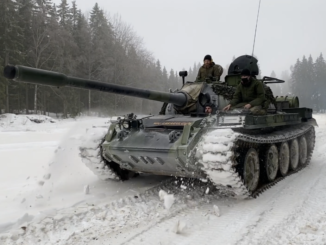I had a chance to shoot an LS26 once before, but without the benefit of a magazine loading tool – and so I could only get 4 or 5 rounds into the mag. This time, we have a proper loader, and we can give the gun a proper workout. And I’ll also show you how that loading tool works – it’s almost as neat as the gun itself!
Overall, I found the LS-26 to be a better shooting experience than I had expected. Properly cleaned and on a nice range, it ran without any problems (until I had a rimlocked round in my last magazine, which was a real problem to fix). As one of Lahti’s early designs, it is understandable that the gun had problems in field service, and I can certainly see why the DP-27 was eagerly taken to replace it at the first opportunity – but the LS-26 is not necessarily fully deserving of it’s very poor reputation.




Let’s see, we have an okay weapon that could have been better. Just be sure not to have anyone stand in the way of that ejector port (flying hot brass to the ankles isn’t a pleasant experience). Nice reloading tool!
Another machinegun that works only in peace. The Russians are updating their small arms, but not the Degturev, of course.
Finnish people commenting a lot on YouTube about the unreliability. Anecdotal information:
Grandfather told that when received by the troops during winter war as they mustered to meet the Russian invasion (first time many saw the new weapon), the new LMGs arrived from depots full of cosmoline. Cleaning instructions were not to disassemble recoil spring mechanism in buttstock. THAT MECHANISM WAS FULL OF COSMOLINE. Subzero weather, cosmoline becomes like stiff wax. Guns did not run well in arctic cold due to mechanism filled with frozen cosmoline…
The possibility for rim lock and a magazine that your assistant gunner can’t refill without standing up during battle certainly couldn’t have helped!
Does anyone have more information about the 8 mm version for the Chinese nationalists?
Great tool. But I doubt one would think so if you needed to load magazines on the run. And apparently, the tool doesn’t guarantee that the rims will line up…
Lol, what a piece of shit.
Sorry, Ian, but as an old soldier, I know that if a piece of equipment ain’t soldier proof, it ain’t any good. Remember Murphy (CPT Ed Murphy, USAF) was a serving officer.
https://www.farmersalmanac.com/what-murphys-law#:~:text=Coined%20in%20the%20middle%20of%20the%2020th%20century%2C,an%20engineer%20working%20on%20Air%20Force%20Project%20MX981
.
US example, the way the gas system could be assembled wrong on the M60. Canadian example, the Ross Rifle.
“Properly maintained” – famous last words. See early use of the M16A1 in Vietnam
Second, experience with a perfectly clean weapon fresh from the arms room on a dry, cool day is not conclusive evidence of worth. How does it function under adverse circumstances?
Last, the prime requirement a soldier has of his weapon is that it be reliable. COL John Weeks, the noted British small arms expert, said of the Vickers Gun, “It was never a truly man-portable weapon, although there are hundreds of men alive today who have sweated and humped it over all sorts of country in all parts of the world…It was awkward, heavy, cumbersome and well loved because it did what was required of it – it gave covering fire. Reliability was its outstanding virtue… it worked and was hardly ever known not to work…The last guns were still in service in 1965, but went soon after that, mourned by all This extraordinary affection was engendered by one virtue only, that of reliability, and shows how much it is valued by the soldier.”
“(…)“Properly maintained” – famous last words.(…)”
Note that before war, gunner were barred from disassemble of trigger group
https://modernfirearms.net/en/machineguns/finland-machineguns/ls-26-eng/
The trigger unit is of rather complicated design; until the start of the Winter War in 1940, its disassembly was permitted only by trained armourers; ordinary gunners were not allowed to disassemble this unit.
Daweo, Any veteran will tell you that somebody will ignore that. Doesn’t matter if its written in the regulations, somebody will ignore them.
As an extreme example, who would wander into an impact area? Well, we had a guy at Ft Lewis, who ignored the fence and “Danger – Keep Out” signs and went, believe it or not, looking for souvenirs. He found what looked neat and picked it up. Unfortunately, what it turned out to be was probably an old 3.5″ AT rocket, complete with its notoriously sensitive Piezoelectric (Lucky Crystal) fuse, from an abandoned range. I was safety officer at another range that day when there was a distant boom, shortly followed by a frantic radio call from Range Control for all ranges to cease fire immediately. Soon after, Reliable Dustoff went overhead to pick up the pieces. I understand what they found wasn’t pretty, but still alive, barely. A couple of days later we had a battalion formation where the Sergeant Major laid down the law to the troops.
https://advanceandreview.wordpress.com/2017/04/27/history-ww2-heat-and-the-piezoelectric-fuze/
In service of the never-ending quest to top the last “Old Soldier’s Story”… I give you this recent headline, validated across many, many sources:
https://www.dailymail.co.uk/news/article-10270067/Man-seeks-medical-help-artillery-shell-lodged-rectum.html
The reason that this sad event cracks me up is that it finally answers a question first posed to me by the then-current signs surrounding the impact areas at Fort Sill, Oklahoma. The thing about those signs that always got a second look and an incredulous one, was the line on them that went something like this: “Do not pick up, harm, or molest any dud rounds”.
There’s something about that line that still makes me question what the author of it was warning about… Surely, if there is any harm to be done, it won’t be harm to the dud, and furthermore, just how the hell does one go about “molesting” a dud munition…?
Up until that news article, the most lurid imagining I could come up with was an image of some deviant, alone in his room, stroking the side of an as-yet undetonated 155mm howitzer round they’d taken from downrange. We actually had a guy do that, absent the stroking (that anyone knew about…), in that he’d wanted one of those model training rounds they displayed in the classrooms at Fort Sill (artillery center, donchaknow…), and the only way he could get one to put in his barracks room was to go downrange, find a dud, bring it back and paint it to look like the real thing. Which he did. They found it on an inspection, EOD was called, and we evacuated several square blocks while they dealt with it, ‘cos dumbass had gone out and brought back not just a live shell, but a live HE shell… With fuze. Intact, functional fuze, that had failed to actuate when it was supposed to, which meant that it was basically about a hairsbreadth from taking out a couple of buildings in the cantonment area there at Fort Sill.
Swear to God, that’s all true. Even the “no molest shell” bit…